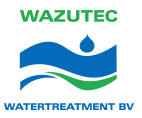Chemical installations
Physical chemical installations are characterised by the use of chemicals to encapsulate the contamination in the waste water in block form. An example of this is the neutralisation installation. Neutralisation works by adding chemicals to the waste water, following which the solid substance is separated. The last particles are then separated, following which the discharge of the purified water can take place. The solid substance is drained in a filter press. Depending upon the properties of the waste water, this is followed by a selective ion exchange or the addition of absorbents. If heavy metals may be present in the waste water, residual values of between 0.5 and 1 mg per litre can be achieved. Traditional disadvantages of physical chemical installations are the high use of chemicals and the accompanying production of sludge.
Wazutec has developed a solution which avoids the traditional disadvantages of physical chemical installations. By applying the ELFLOX® system, standard effluent values of 0.02 – 0.3 mg per liter can be achieved. That’s why we under-run neutralisation installations with a factor of 3-35 and why a sludge reduction to 90 percent is achieved. The capacity of a neutralisation installation combined with an ELFLOX® system can vary from 0.5 m3 – 200 m3 per hour.
